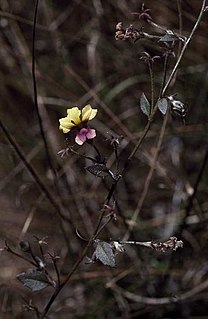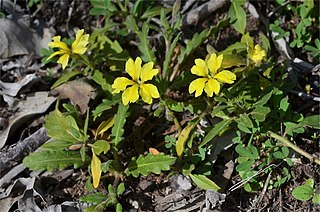
Goodenia lanata, commonly known as trailing goodenia in Victoria and native primrose in Tasmania is a species of flowering plant in the family Goodeniaceae and is endemic to south-eastern Australia. It is a prostrate or low-lying perennial herb with hairy, egg-shaped leaves and racemes of yellow flowers.

Goodenia arachnoidea is a species of flowering plant in the family Goodeniaceae and is endemic to Western Australia. It is an erect to ascending herb with egg-shaped leaves with the narrower end towards the base, and racemes of yellow flowers with leaf-like bracts at the base.

Goodenia berardiana is a species of flowering plant in the family Goodeniaceae and is endemic to Australia. It is an erect, widely distributed and variable annual herb with linear to egg-shaped, sometimes lobed or toothed leaves, and yellow flowers arranged in leafy racemes or few-flowered umbels.
Goodenia campestris is a species of flowering plant in the family Goodeniaceae and is endemic to northern Australia. It is a low-lying herb with egg-shaped to lance-shaped stem leaves and racemes of yellowish flowers with purple veins.

Goodenia convexa is a species of flowering plant in the family Goodeniaceae and is endemic to Western Australia. It is a low-lying herb with egg-shaped to lance-shaped, usually toothed leaves mostly at the base of the plant, and racemes of yellow flowers.
Goodenia coronopifolia is a species of flowering plant in the family Goodeniaceae and is endemic to north-western Australia. It is a herb with mostly linear leaves, those at the base of the plant divided with narrow segments, racemes of yellow flowers with brownish-purple markings, and more or less spherical fruit.

Goodenia cycloptera is a species of flowering plant in the family Goodeniaceae and is endemic to Australia. It is a widely distributed, perennial or annual herb with wavy or toothed leaves, yellow flowers arranged in leafy racemes and more or less spherical fruit.
Goodenia durackiana is a species of flowering plant in the family Goodeniaceae and is endemic to north-western Australia. It is an erect to low-lying herb with elliptic to oblong stem leaves with coarse teeth on the edges, and racemes of yellow flowers.
Goodenia forrestii is a species of flowering plant in the family Goodeniaceae and is endemic to Western Australia. It is an ascending to low-lying herb with elliptic to lance-shaped leaves with teeth on the edges, and racemes of yellow flowers with a brownish centre.

Goodenia glabra, commonly known as shiny pansy or smooth goodenia, is a species of flowering plant in the family Goodeniaceae and is endemic to drier inland areas of Australia. It is a prostrate to low-lying herb with lobed, oblong to egg-shaped leaves, and racemes of yellow flowers with purplish markings.
Goodenia glandulosa is a species of flowering plant in the family Goodeniaceae and is endemic to dry, inland areas of Australia. It is an erect, perennial herb with linear to lance-shaped leaves and racemes of yellow flowers.
Goodenia granitica is a species of flowering plant in the family Goodeniaceae and endemic to the south-west of Western Australia. It is an annual herb with spatula-shaped, sometimes lobed leaves, in a rosette at the base of the plant, and racemes of yellow flowers.
Goodenia heatheriana is a species of flowering plant in the family Goodeniaceae and is endemic to Western Australia. It is a spreading annual herb with narrow egg-shaped leaves at the base of the plant and racemes of yellow flowers.
Goodenia iyouta is a species of flowering plant in the family Goodeniaceae and is endemic to Western Australia. It is a prostrate herb with toothed, egg-shaped to elliptic stem-leaves, and racemes of dark yellow or cream-coloured flowers with a distinct pouch.
Goodenia lancifolia, commonly known as scruffy goodenia, is a species of flowering plant in the family Goodeniaceae and is endemic to the far south-west corner of Western Australia. It is a perennial herb with linear to narrow egg-shaped at the base and stem-clasping, lance-shaped to egg-shaped stem-leaves and blue flowers with a white centre.
Goodenia lyrata is a species of flowering plant in the family Goodeniaceae and is endemic to inland areas of Western Australia. It is a prostrate herb with densely hairy, lyrate leaves at the base of the plant, smaller leaves on the stem and racemes of yellow flowers.
Goodenia maideniana is a species of flowering plant in the family Goodeniaceae and is endemic to inland areas of Western Australia and the Northern Territory. It is a prostrate or low-lying herb with toothed, egg-shaped leaves at the base of the plant, and racemes of yellow flowers.
Goodenia malvina is a species of flowering plant in the family Goodeniaceae and is endemic to north-western Australia. It is a prostrate to low-lying herb with egg-shaped to lance-shaped leaves on the stems and racemes of mauve to pinkish and yellowish flowers.
Goodenia megasepala is a species of flowering plant in the family Goodeniaceae and is endemic to Queensland. It is a prostrate to low-lying herb with toothed or lobed, lance-shaped to narrow elliptic leaves, and racemes of yellow flowers.

Goodenia microptera is a species of flowering plant in the family Goodeniaceae and is endemic to the Pilbara region of Western Australia. It is an erect to ascending, sprawling herb with narrow oblong to lance-shaped leaves sometimes with teeth on the edges, and racemes of yellow flowers with a brownish centre.






